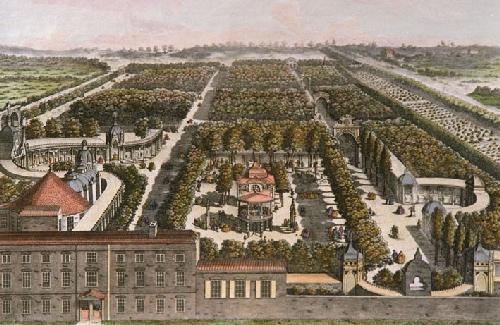Samuel Wale on:
[Wikipedia]
[Google]
[Amazon]
Samuel Wale (1721? – 1786) was an English historical painter and book illustrator.


Life
He is said to have been born atGreat Yarmouth
Great Yarmouth ( ), often called Yarmouth, is a seaside resort, seaside town which gives its name to the wider Borough of Great Yarmouth in Norfolk, England; it straddles the River Yare and is located east of Norwich. Its fishing industry, m ...
, Norfolk
Norfolk ( ) is a Ceremonial counties of England, ceremonial county in England, located in East Anglia and officially part of the East of England region. It borders Lincolnshire and The Wash to the north-west, the North Sea to the north and eas ...
, possibly on 25 April 1721, to Samuel and Margaret Wale, though some sources indicate he was born in London. He was first trained in the art of engraving on silver plate. He then studied drawing under Francis Hayman
Francis Hayman (1708 – 2 February 1776) was an English painter and illustrator who became one of the founding members of the Royal Academy in 1768, and later its first librarian.
Life and works
Born in Exeter, Devon, Hayman begun his arti ...
at the St. Martin's Lane academy. Wale assisted John Gwynn in his architectural drawings, especially in a transverse section of St Paul's Cathedral
St Paul's Cathedral, formally the Cathedral Church of St Paul the Apostle, is an Anglican cathedral in London, England, the seat of the Bishop of London. The cathedral serves as the mother church of the Diocese of London in the Church of Engl ...
, which was engraved and published in their joint names in 1752.
He became one of the original members of the Society of Artists of Great Britain in 1765 and of the Royal Academy
The Royal Academy of Arts (RA) is an art institution based in Burlington House in Piccadilly London, England. Founded in 1768, it has a unique position as an independent, privately funded institution led by eminent artists and architects. Its ...
in 1768, and was the first professor of perspective to the Academy. He exhibited drawings of scenes from English history, and occasionally scriptural subjects, described as designs for altar-pieces, from 1769 to 1778, when he suffered from a paralytic stroke, and he was placed on the Royal Academy pension fund, the first member who benefited by it. He continued to hold the professorship of perspective, though he gave private instruction at his own house instead of lecturing; and in 1782, on the death of Richard Wilson, he became librarian. He held both offices until his death on 6 February 1786. Unmarried and childless, he left his copperplates, prints, and belongings to his friend and fellow founder of the Royal Academy, architect John Gwynn, with whom he shared his house, and his nurse, Mrs. Mary Gurpin. He was buried in St. Martin-in-the-Fields. His portrait appears in Johann Zoffany
Johan / Johann Joseph Zoffany (born Johannes Josephus Zaufallij; 13 March 1733 – 11 November 1810) was a German neoclassical painter who was active mainly in England, Italy, and India. His works appear in many prominent British collections ...
's picture of the Royal Academy in 1772, engraved by Richard Earlom.
Works
He painted some decorative designs for ceilings at a time when the taste for that style of ornamentation was on the wane, and he was occasionally employed in painting tradesmen's signs, till these were prohibited by act of parliament in 1762. A full-length portrait of Shakespeare by Wale, which hung across the street outside a tavern nearDrury Lane
Drury Lane is a street on the boundary between the Covent Garden and Holborn areas of London, running between Aldwych and High Holborn. The northern part is in the borough of London Borough of Camden, Camden and the southern part in the City o ...
, obtained some notoriety owing to the splendour of the frame and the ironwork by which it was suspended. It had scarcely been erected when it had to be removed.
His main work was in designing vignettes and illustrations on a small scale for the booksellers; a large number these were engraved by Charles Grignion the Elder. Among them were the illustrations to the ‘History of England,’ 1746–7; ‘The Compleat Angler,’ 1759; ‘London and its Environs described,’ 1761; ‘Ethic Tales and Fables,’ William Wilkie's ‘Fables,’ 1768 (eighteen plates); Henry Chamberlain's ‘History of London,’ 1770; and Oliver Goldsmith
Oliver Goldsmith (10 November 1728 – 4 April 1774) was an Anglo-Irish people, Anglo-Irish poet, novelist, playwright, and hack writer. A prolific author of various literature, he is regarded among the most versatile writers of the Georgian e ...
's ‘Traveller,’ 1774. His book illustrations show Hayman's influence.
He also published numerous plates in the '' Oxford Magazine'' and other periodicals. He exhibited ‘stained drawings,’ i.e. designs outlined with the pen and washed with indian ink
India ink (British English: Indian ink; also Chinese ink) is a simple black or coloured ink once widely used for writing and printing and now more commonly used for drawing and outlining, especially when inking comic books and comic strips. In ...
, and occasionally larger drawings in watercolours, at the exhibitions of the Society of Artists in Spring Gardens, 1760–1767, and designed the frontispiece to the catalogue in 1762.
References
* ;AttributionExternal links
* {{DEFAULTSORT:Wale, Samuel 1786 deaths 18th-century English painters English male painters English draughtsmen English engravers English illustrators Royal Academicians Year of birth uncertain People from Great Yarmouth 18th-century English male artists